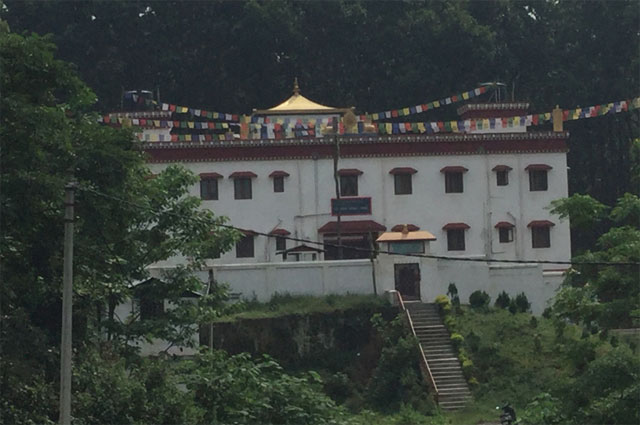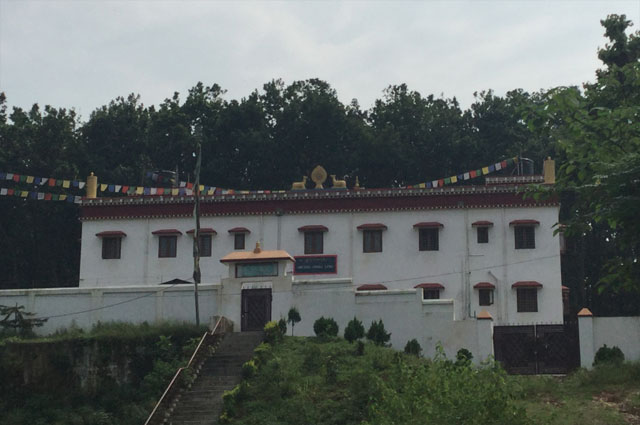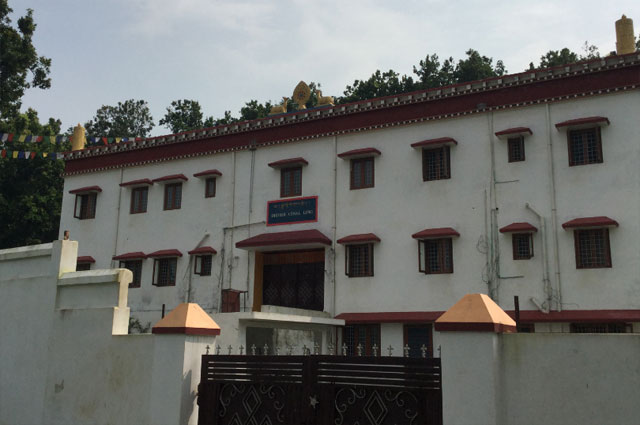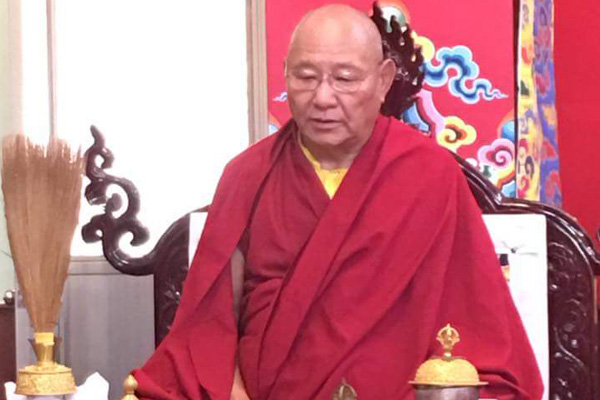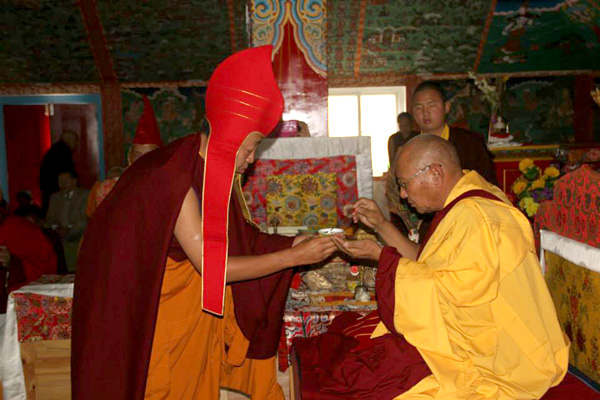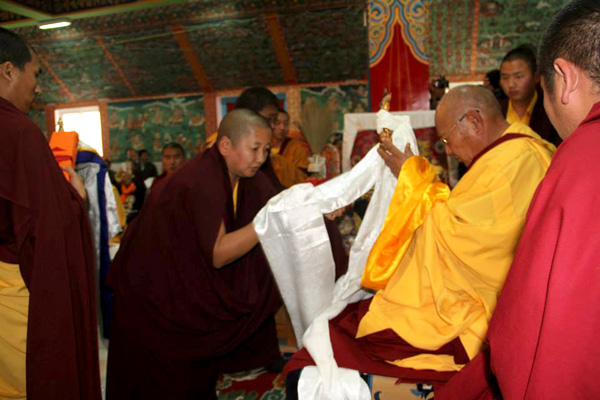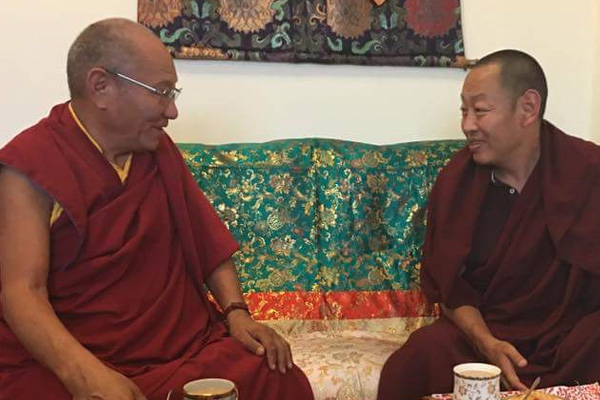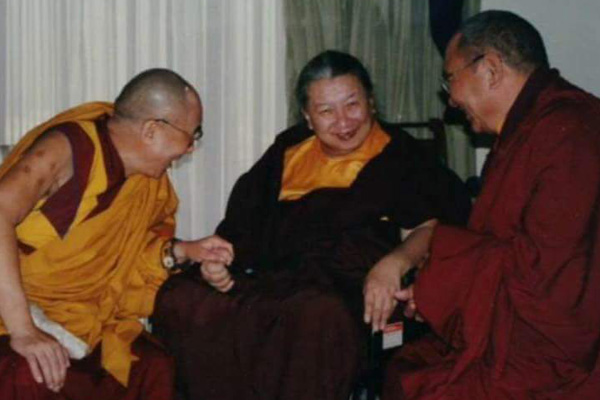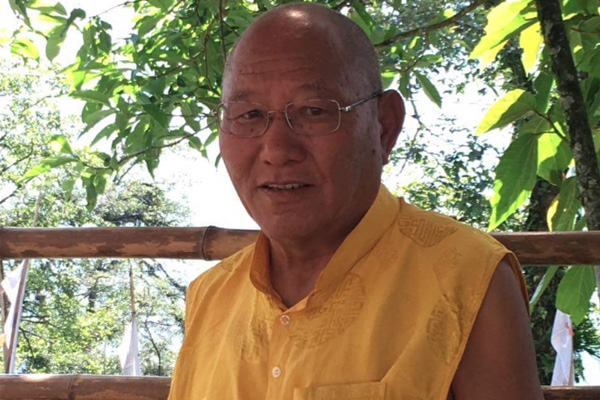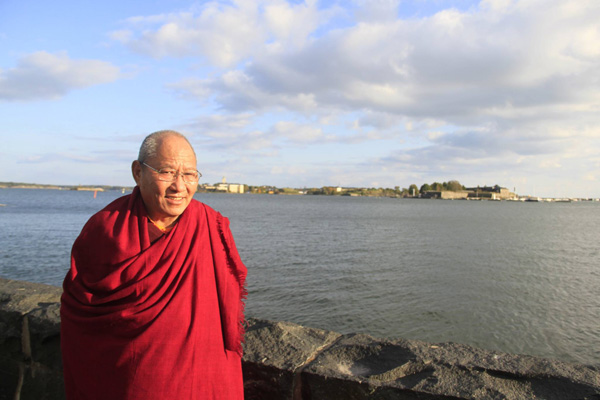Mindrolling 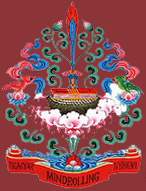 Monastery
Monastery
Mindrolling in India
Set in the foothills of the Himalayas in Dehra Dun in North India, Mindrolling is one of the largest Buddhist centers in India today, and includes the following:
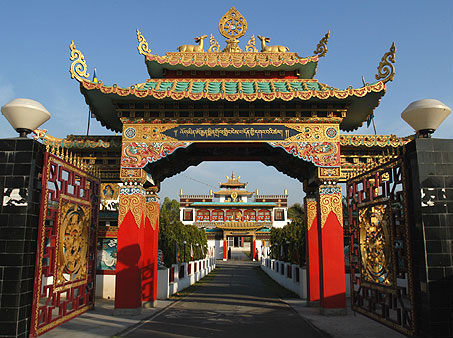
Ngedon Gatsal Ling
Ngedon Gatsal Ling is the main monastery and practice center. The daily prayers as well as the Drubchens (Mahasadhanas) are performed here. Monks learn and practice rituals, mandala drawing, lama dances and the playing of ritual instruments. Monks can also choose to study thangka painting and sculpting.
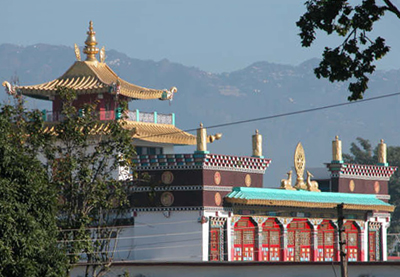
Ngedon Gatsal Ling – Today

Ngedon Gatsal Ling – 1978
Primary and Secondary Buddhist School
The Primary and Secondary Buddhist School has eight levels where the monks study recitation, calligraphy, grammar, poetry, recitation, philosophy and English. On the completion of the eight levels, monks can join the Ngagyur Nyingma College or continue to practice in the main monastery.
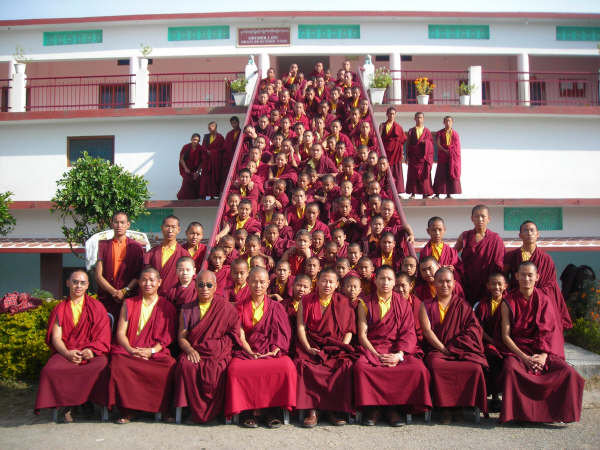
Drubde Ödsal Ling
DrubdeÖdsal Ling is the retreat centre where monks undertake retreats of various lengths varying from 3-month to 3 years of solitary retreat. Before going into retreat, monks are given teachings and receive profound and advanced Buddhist meditation instructions from the Rinpoches. But the area where the retreat centre was located became noisy with the coming of great Stupa (ChoetenChenmo) nearby thus disturbing who are in retreat.
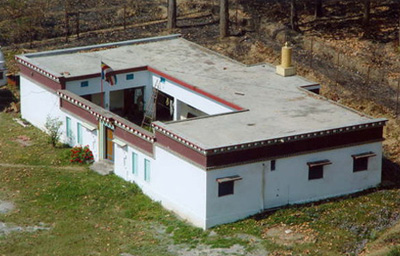
Old retreat center
New retreat center
The new Retreat Centre was inaugurated on December 2nd in Mindrolling where all of the Rinpoches, Tulkus, Khenpos and monks attended.. The retreat centre has twenty-five rooms, a shrine room and many other facilities required for the retreatants. The problem was later on solved when Venerable TulkuUgyenChophel Rinpoche sponsored for the entire new retreat centre project in the new location. The present retreat centre is away from the public gatherings the cremation ground nearby it makes it more authentic. As said in supplication by YeshiTsogyal to guru Rinpoche.
“Charnel grounds, hermitages, retreats amid the snows, And other secluded places with all the perfect qualities, Let the quintessence of profound samadhi meditation be my constant practice”
Stupa Inauguration and Consecration Ceremony

The facade of the main stupa contains a magnificent relief of Maitreya, the future Buddha. Descending from the tri-colored steps (representing lapis lazuli, gold and silver) of the stupa is Buddha Shakyamuni. The artwork within this stupa is an outstanding example of Buddhist art. The main stupa has five main shrine rooms. The ground floor level’s shrine is of Guru Padmasambhava and its main statue is his manifestation as Guru Lakeborn Vajra. The life-story of the glorious Guru Padmasambhava is painted on the walls in accordance with the terma of Ogyen Lingpa, the Crystal Cave Chronicles [bKa’-thang Shel-brag-,ma], which consists of one hundred and eight chapters.
Also included are the paintings of the Seven Chapter Supplication [Le’u bDun-ma], the Supplication for Clearing the Obstacles to the Path [Bar-chad Lam-sel], the Outer, Inner and Secret Assembly of Heart Essence of Vidyadharas [Rigs’dzin Thug-thigs], the short description of the past lives of Terdak Lingpa, the One Hundred and Eight Mahasiddhas of India, the Twenty-five Disciples of Padmasambhava, the One Hundred and Eight Great Treasure Masters, the Eight Great Chariots of the Practice Lineage, and the Dharmapalas who protect the Dharma.
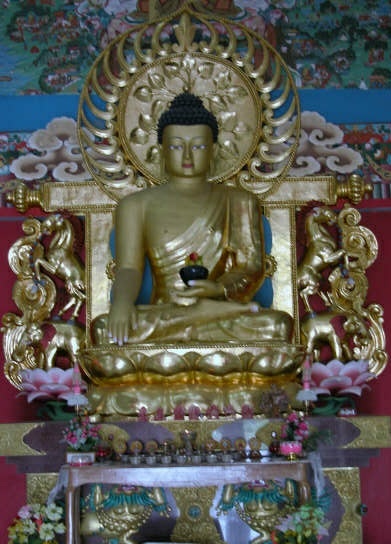
The shrine room on the first floor is dedicated to Shakyamuni Buddha. The murals on the walls depict the Jataka tales according to the text Wish-fulfilling Tree [rTog-brjod dpak-bsam Khri-shing], written by the Dharma king Kshemendra. The 16 great arhats, the seven entrusted with the teachings, and the 17 panditas of Nalanda, India, are shown on the pillars.
The shrine room above contains statues of the descendants of Terdag Lingpa, the great throne holders [Khris-chen] and the lineage of the supreme abbots [mKhan-chen]. A magnificent 3-dimensional mandala of the union of the oral lineage transmission [bKa’-ma] and the treasure teachings [gTer-ma], based on Lochen Zhi-khro, is built in the center of the shrine room. In addition to these, there are paintings of the precious lineage masters of the Patrimoksha, Bodhisattvayana, and Vajrayana.
In the vase enclosure of the stupa are the images of the thousand Buddhas of ‘the Good Aeon’. In it are the statues of the field of accumulation that embodies the entire qualities of the three secrets of all the victorious sugatas, based on’ Ati Zab-don snying-po, the extraordinary tradition revealed by Terdak Lingpa.

The shrine room above the vase contains the statues of the five families of Buddha, along with Buddha Amitabha. The walls are painted with a depiction of the twelve teachers of the Dzogchen lineage. The life-force tree is shown in accordance with the mandala and the stupa ritual of the Two Aspects of Stainlessness [Dri-med rNam-gnyis]. The upper and the lower end of the life-force tree is anointed with saffron water, and it is covered with silk. There are over one hundred and eleven extremely secret Dharanis from sutras and tantras including the five great sections of dharanis. Dharani of Rigpa Phugron and of Akshobya. Alphabets and the mantra of the essence of Dependent Origin are also found with them. All the dharanis are arranged in compliance with ‘the Practical Guide on Offering Dharani’ text by Lochen Dharmashri.
The neck of the stupa lies above the vase and below the 13 golden colored tapering wheels of Dharma. It is filled with the texts of the Buddhist canon as well as earlier and later versions of commentaries translated into Tibetan. It also includes the works of the famous Six Ornaments and Two Supreme Ones, Rongzom, Mahapandita, the Omniscient Longchenpa, Terdag Lingpa and Lochen Dharmashri. Also included are a number of tsa-tsa built according to the ritual of Drimed Namnyi. Additionally, there are brass statues: five of Buddha Muni, one of Green.Tara, one of the Lake-born Guru with his retinue of two, Standing Ksitigarbha, and one of Manjushri. There is a silver statue of Vajrasattva, a gold and. copper statue of Buddha Amitabha, Phurpa of Nyang-gter, a Samye. Dora [vajra], and a holy brass statue of Java Shakyamuni presented by Dzongsar Khentse Rinpoche.
Relics of the four different types are also kept there, namely: the relics of the Dharmakaya [chas-sku’i ring-bsrel], such as Guru Rinpoche’s tooth (offered by Nyenchen Thangla) and relics of Buddha Kashyapa; relics of the cremated bodies of holy saints [sku-gdung-gi ring-bsrel]; relics of the saints’ robes [sku-bal-gyi ring-bsrel]; and relics resembling mustard seed [Yung-‘bru lta-bu’i ring-bsrel].
Furthermore, the stupa also houses a collection of numerous other spiritual objects of spontaneous origin, as well as various indisputably holy substances that were passed down from the reliable sources. These are all full of blessings. Every aspect of this stupa was built under the guidance of the most venerable Khochhen Rinpoche and follows the famous stupa-building guidelines of Phugpa and his heart sons, Lochen Dharmashri, and other reliable sources.
Primary Health Care Clinic
A primary health care clinic, known as Tsering Gatsal, has been set up on the monastery’s premises for the monks and local community. Qualified doctors provide both modern and Tibetan medicine.

Guesthouses/Dining/Conference Rooms
Dekyi Gatsal Guesthouse is a well-furnished lodge of nine double-bedded rooms with attached baths. It also has a kitchen and dining room for the use of the guests.
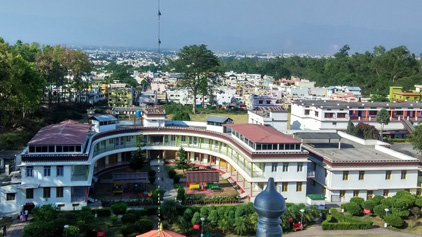
Deva Loka Guesthouse has double rooms that occupy the second floor of a lovely, curved building. Doors open to the balcony where one has a superb view of the Great Stupa and the courtyard below with its cafe tables and flower beds.
Deva Loka’s lower level features gift shops, a restaurant, an internet cafe, and the relocated Peace Cafe, all managed by residents of the Clement Town Tibetan community adjacent to Mindrolling. Two new dining areas have been constructed on the roof of the Deva Loka Guesthouse. Built almost entirely of glass, the facilities will provide diners with beautiful views of the Stupa and all of Mindrolling. Hosting of conferences and group activities may now be held within a beautiful and spacious environment in the heart of the Mindrolling campus.
The Community Prayer Hall
A large community prayer hall of the Tibetan Colony of Clement Town is on the premises of the monastery and is at the disposal of the Mindrolling monastery. The top floor consists of dormitories for the younger monks and classrooms of the Primary and Secondary Buddhist School.
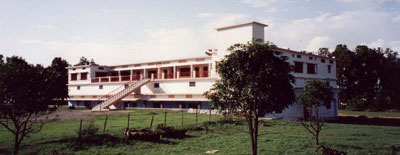
Mindrolling Centers
There are various other Mindrolling centers. A retreat center and monastery of Mindrolling is in Kalimpong in Eastern India. There are Mindrolling centers of practice and study in Mongolia and Taiwan.
Administration
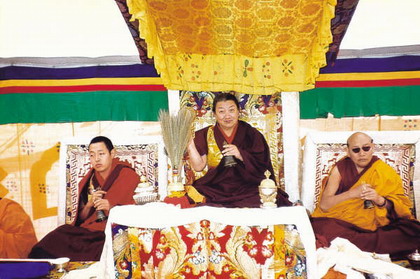
The Mindrolling monastery was headed by His Holiness the XIth Mindrolling Trichen, and administered by the Ven. D.G. Khochhen Rinpoche. Ngagyur Nyingma Institute is headed by His Eminence Khenchen Rinpoche. In addition to many tulkus and khenpos, Mindrolling today includes over 300 monks.
The monastery is a Charitable Society registered in India under the Societies Registration Act of 1860 as ‘Nyingmapa Mahabodhi Charitable Society’. Besides providing Buddhist education and research, the organization preserves and promotes Buddhism and Tibetan culture. The monastery provides free food, accommodation, clothing, medical care and education including textbooks and stationery to over 300 monks. The sole source of income is voluntary donations.

The extensive planning and construction began in 1965 under the vision and effort of the Ven. D.G. Khochhen Rinpoche and the late Ven. Jampal Lodro Rinpoche. Since then, many have contributed in various ways to the monastery and its sangha. Today the entire sangha of monks, nuns, and lay people continue to work in propagating and preserving the Dharma.
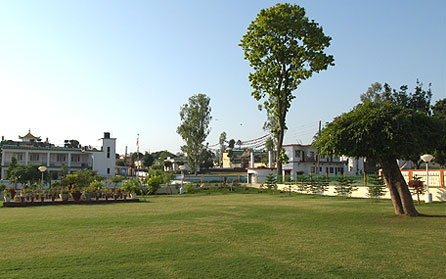
The Venerable Khochhen Rinpoche
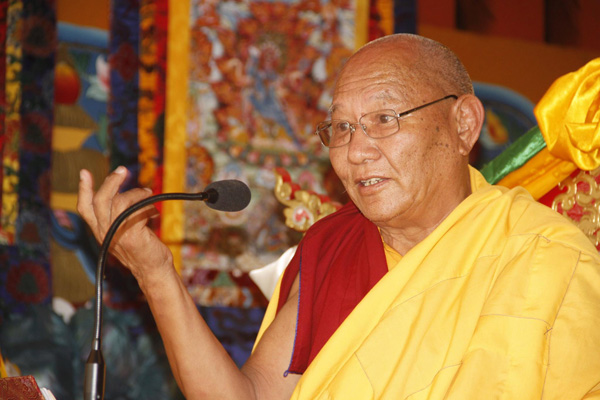 His Eminence Kyabje Khchen Rinpoche (Jurme Dogyud Gyatso) was born in 1937 in Gonjo Dodrup in Eastern Tibet. He was recognized as the reincarnation of Namdrol Sangpo Rinpoche of Khochhen monastery at an early age by His Eminence the 8th Mindrolling Khenchen. Ter-say Chime Rinpoche, who was the elder brother of Dzongsar Khyentse Chökyi Lodrö, formally enthroned Rinpoche at Khochhen monastery. Rinpoche undertook his studies in Mindrolling in Tibet where he studied and mastered Buddhist philosophy, psychology, tantras, astrology, poetry, literature, calligraphy and rituals. He received profound teachings and instructions from eminent masters such as Dzongsar Khyentse Chökyi Lodrö, Minling Chung Rinpoche and Minling Khenchen Rinpoche. Rinpoche was at Mindrolling for well over ten years until the Communist invasion in 1959. Following the invasion, Rinpoche, at the age of 22, escaped into exile in India as one of the seven-member entourage of His Holiness Mindrolling Trichen.
His Eminence Kyabje Khchen Rinpoche (Jurme Dogyud Gyatso) was born in 1937 in Gonjo Dodrup in Eastern Tibet. He was recognized as the reincarnation of Namdrol Sangpo Rinpoche of Khochhen monastery at an early age by His Eminence the 8th Mindrolling Khenchen. Ter-say Chime Rinpoche, who was the elder brother of Dzongsar Khyentse Chökyi Lodrö, formally enthroned Rinpoche at Khochhen monastery. Rinpoche undertook his studies in Mindrolling in Tibet where he studied and mastered Buddhist philosophy, psychology, tantras, astrology, poetry, literature, calligraphy and rituals. He received profound teachings and instructions from eminent masters such as Dzongsar Khyentse Chökyi Lodrö, Minling Chung Rinpoche and Minling Khenchen Rinpoche. Rinpoche was at Mindrolling for well over ten years until the Communist invasion in 1959. Following the invasion, Rinpoche, at the age of 22, escaped into exile in India as one of the seven-member entourage of His Holiness Mindrolling Trichen.
Since the establishment of Mindrolling in India, His Eminence Khochhen Rinpoche has worked tirelessly for the construction and maintenance of Mindrolling monastery. His efforts and perseverance have played a major role in every development in the monastery through the years. Besides being the principal of the Mindrolling Monastery, Rinpoche is also the President of the Tibetan community in Clement Town since the year 1987.
In the recent years, Rinpoche have been working tirelessly in new Mindrolling center in Northen States. The Ugyen Mindroll Samtenling center was established in Kalimpong. Rinpoche take more time in looking after the monasteries in Sikkim and Darjeling since early 2000.

